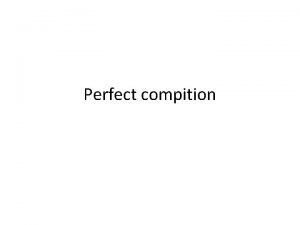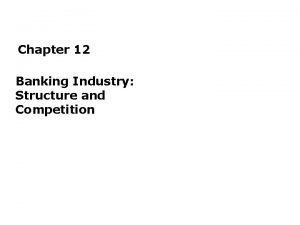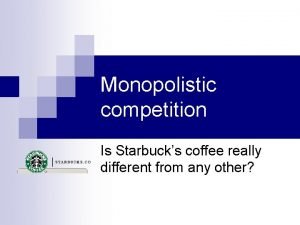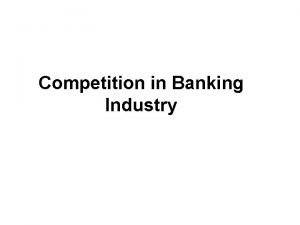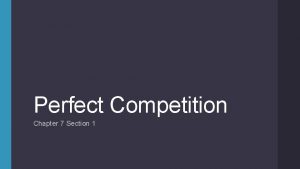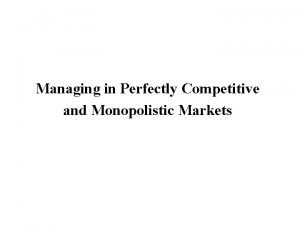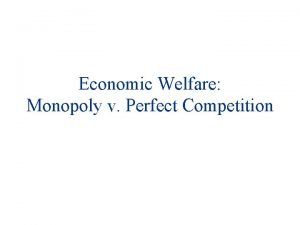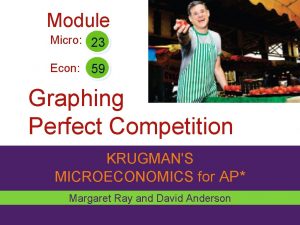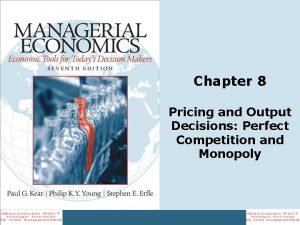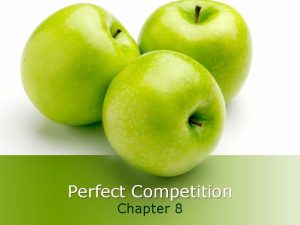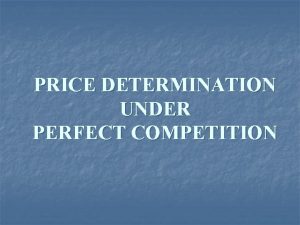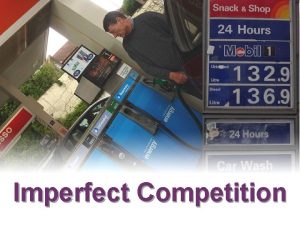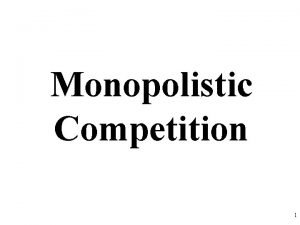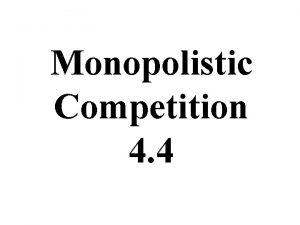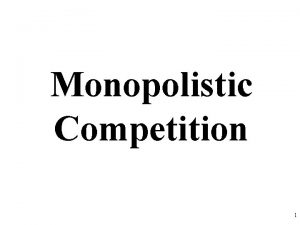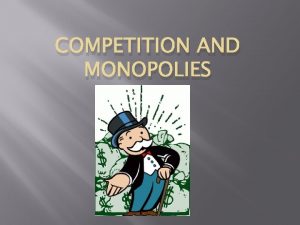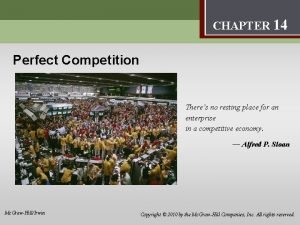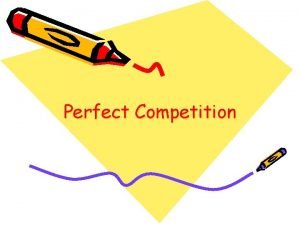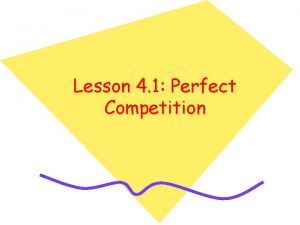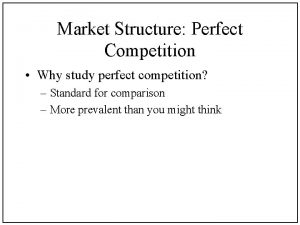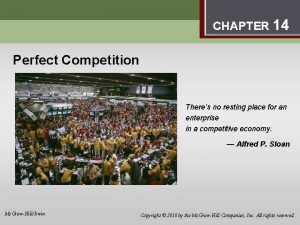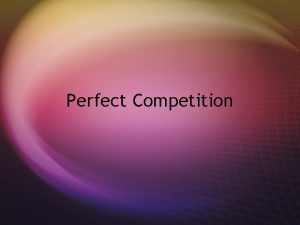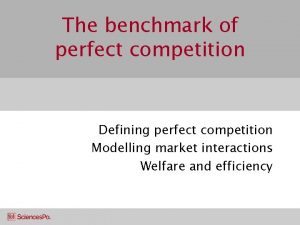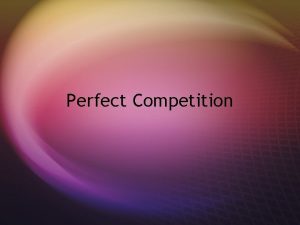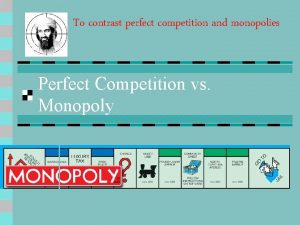Perfect compition Perfect competition is an industry in























- Slides: 23

Perfect compition

Perfect competition is an industry in which(conditions of perfect competition) 1 -Many firms sell identical(the same) products to many buyers. 2 -There are no restrictions to entry into the industry. 3 -Established firms have no advantages over new ones. 4 -Sellers and buyers are well informed about prices. 5 -the units of the product are homogenous.

Definitions: Total revenue is the sum that the seller received from selling *units of the product. *Total Revenue(TR)= price x # units of the sales. *Marginal Revenue (MR)is the change in TR which results from(divided ) a change in # sales. *MR= change in TR /change in #of sales *Average Revenue (AR) is the revenue of each units of the sales *AR=TR/#units of the sales. *profit= TR – TC. *The goal of each firm is to maximize economic profit.

Price Takers: In perfect competition, each firm is a price taker. *A price taker is a firm that cannot influence the price of a good or service. *No single firm can influence the price—it must “take” the equilibrium market price. *Each firm’s output is a perfect substitute for the output of the other firms, so the demand for each firm’s output is perfectly elastic.

This graph illustrates a firm’s revenue concepts. Part (a) shows that market demand market supply determine the market price that the firm must take.

Figure: illustrates a firm’s revenue concepts.

*The demand for a firm’s product is perfectly elastic because one firm’s sweater is a perfect substitute for the sweater of another firm. *The market demand is not perfectly elastic because a sweater is a substitute for some other good.

*A perfectly competitive firm’s goal is to make maximum economic profit, given the constraints it faces. *So the firm must decide: 1. How to produce at minimum cost 2. What quantity to produce 3. Whether to enter or exit a market We start by looking at the firm’s output decision.

Profit-Maximizing Output: *There are 2 ways to determine the profit of producer TR &TC and MR & MC. The first way is TR&TC: *This figure on the next slide looks at these curves along with the firm’s total profit curve.


*Part (a) shows the total revenue, TR, curve. *Part (a) also shows the total cost curve, TC, . *Total revenue minus total cost is economic profit (or loss), shown by the curve EP in part (b). *At low output levels, the firm makes an economic loss—it can’t cover its fixed costs. At intermediate output levels, the firm makes an economic profit.

*The second way is MR &MC: marginal revenue is constant and marginal cost increases as output increases, profit is maximized by producing the output at which marginal revenue, MR, equals marginal cost. MC *This figure on the next slide shows the marginal analysis that determines the profit-maximizing output. The conditions of equilibrium of producer: 1 -MR=MC 2 -MC is increasing.


*We have 3 cases of equilibrium of producer: 1 -case of economic profit ( positive profit). 2 -case of break-even point(no profit and no loss) 3 -case of economic loss(negative profit).

1 - Case of economic profit:

2 -Case of break- even • point: •

3 -Case of economic • loss: •

*If the firm makes an economic loss it must decide to exit the market or to stay in the market. If the firm decides to stay in the market, it must decide whether to produce something or to shut down temporarily. The decision will be the one that minimizes the firm’s loss.

Loss Comparison: *The firm’s loss equals total fixed cost (TFC) plus total variable cost (TVC) minus total revenue (TR). *Economic loss =( TFC + TVC) TR *If the firm shuts down, Q is 0 and the firm still has to pay its TFC( this is loss). *So the firm incurs an economic loss equal to TFC. This economic loss is the largest that the firm must bear( here the price = AVC at its minimum).

*A firm’s shutdown point is the price is less than the minimum level of AVC. *It is the point at which the MC curve crosses the AVC curve. *The firm incurs a loss equal to TFC.


*Last graph shows the shutdown point. Minimum AVC is $17 a sweater. If the price is $17, the profit-maximizing output is 7 sweaters a day. The firm incurs a loss equal to the red rectangle.

*If the price of a sweater is between $17 and $20. 14, the firm produces the quantity at which marginal cost equals price. *The firm covers all its variable cost and at least part of its fixed cost. *It incurs a loss that is less than TFC.
 Shut down point
Shut down point Perfect competition vs monopolistic competition
Perfect competition vs monopolistic competition Lump sum subsidy
Lump sum subsidy Monopoly vs monopolistic competition
Monopoly vs monopolistic competition Monopoly vs oligopoly venn diagram
Monopoly vs oligopoly venn diagram Banking industry structure and competition
Banking industry structure and competition Is starbucks a perfect competition
Is starbucks a perfect competition Types of competition in banking industry
Types of competition in banking industry Competition in tourism industry
Competition in tourism industry Free entry and exit
Free entry and exit Perfect pitch challenge
Perfect pitch challenge Long run market supply curve
Long run market supply curve Consumer surplus in perfect competition
Consumer surplus in perfect competition Short run equilibrium under perfect competition
Short run equilibrium under perfect competition Perfect competion examples
Perfect competion examples Monopoly deadweight loss
Monopoly deadweight loss Graphing perfect competition
Graphing perfect competition Short run equilibrium under perfect competition
Short run equilibrium under perfect competition Short run equilibrium
Short run equilibrium Pricing and output decisions in perfect competition
Pricing and output decisions in perfect competition Many sellers many buyers
Many sellers many buyers Disadvantages of perfect competition
Disadvantages of perfect competition Perfect competition def
Perfect competition def Disadvantages of perfect competition
Disadvantages of perfect competition
